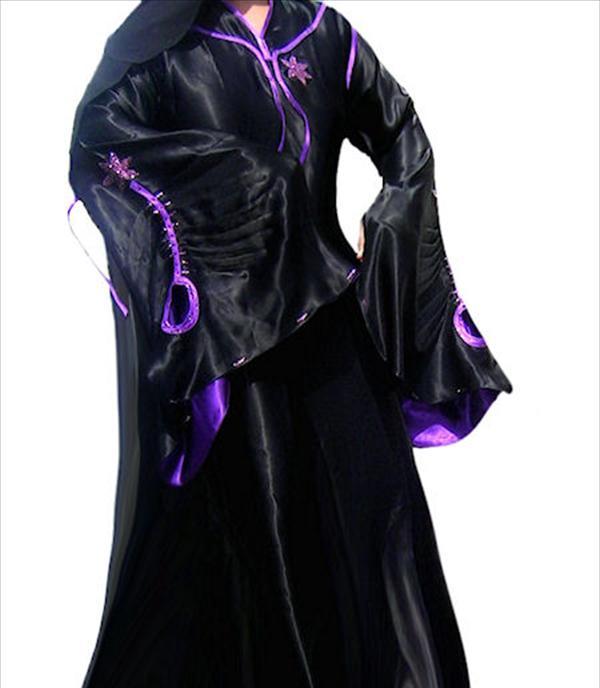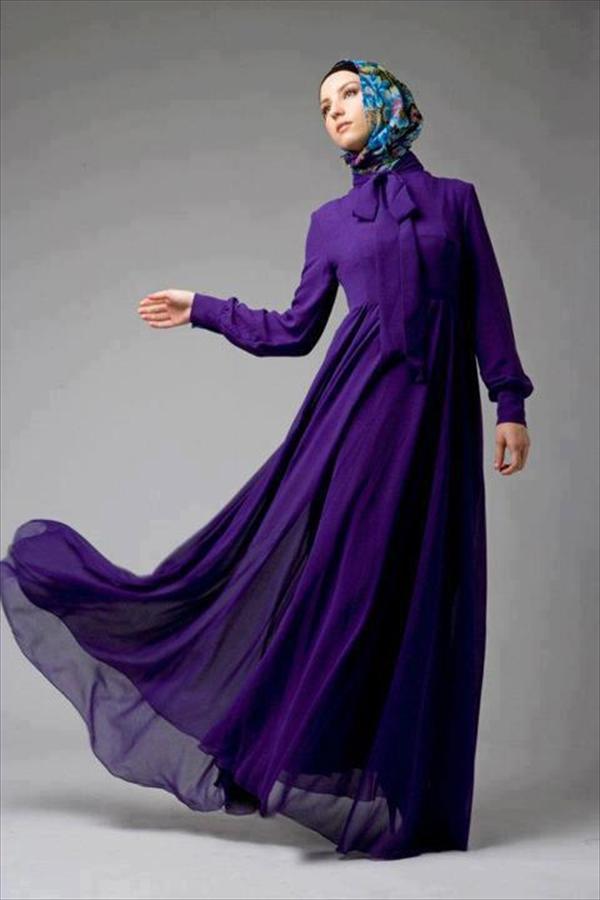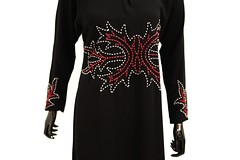About Jilbaab
Source (google.com.pk)
The following excerpt was taken from the book “Masaa’il Nisaa’iyyah Mukhtaarah min Fiqh al-‘Alaamah Al-Albaanee” [Selected Women's Issues from the Fiqh of Imaam Al-Albaanee] compiled by Umm Ayoob Ghaawee. This book contains a collection of Al-Albaanee’s opinions on various issues related to women transcribed from his books, recorded lessons and lectures.
Shaikh Al-Albaanee was asked the following question in a recorded talk: “We would like more details on the definition of a jilbaab, since you have stated that your view on the jilbaab is that it is a garment that covers the body from the head to the feet. However, we have come across a rather large difference of opinion in the language books concerning this. Amongst the linguists are those who say it is a large gown, while others say it is a khimaar. And others hold the same view you mentioned, Shaikh. So we would like a further elaboration, may Allaah reward you, as well as which one is the strongest opinion.”
The Shaikh responded to the questioner: “I’m sorry but I’m having difficulty understanding the part where you said that some people hold the jilbaab to be the khimaar. What is the khimaar that you are referring to when you say that they consider it to be the jilbaab? This is because it is well-known that the khimaar is a head-covering and not an ample garment that covers a woman’s entire body from her head to her feet. So who is it that claims that the jilbaab is a khimaar from what you know, according to what I mentioned? This is truly a very strange thing. Who said this?!”
The questioner said: “This is mentioned in the book Lisaan-ul-‘Arab, where it states that such a definition for it is held by some people.”
The Shaikh said: “It states that the jilbaab is a khimaar?”
The questioner said: “Yes.”
So the Shaikh replied: “It is not possible to say this because as you know there are two ayahs in the Qur’aan – one ayah that orders women to wear the jilbaab while the other orders them to put on the khimaar. It is not possible to say that both ayahs contain a repetition of the same meaning, thus the jilbaab would be the khimaar, while the khimaar would be the jilbaab. Rather, both of these terms – the jillbaab and the khimaar – have their own respective meanings that are distinct from one another.
You know, for example, that when a woman is at home and she gets up to pray her obligatory prayers, for the most part, she is normally at home with her hair uncovered. So she just places her khimaar over her head. The Prophet (sallAllaahu ‘alayhi wa sallam) said: ‘Allaah does not accept the prayer of a mature woman unless she has a khimaar.’
What is meant here is not the jilbaab at all, but rather what is meant is the head-covering. From the evidences that indicate this is that the Prophet (sallAllaahu ‘alayhi wa sallam) ordered us to wipe over the turban or the khimaar or the socks.
My objective behind this hadeeth is to show that it indicates that the khimaar is a garment that both men and women – males and females – share in wearing.
It cannot be understood from this, for those who understand the Arabic language, that a man can place a jilbaab over himself! Rather, it means that he can place a khimaar (head-covering) over himself.
So it is permissible for a person that places a khimaar over his head to wipe over it (when performing ablution), regardless of whether it is a man or a woman. My objective behind this discussion is to firstly confirm the quote according to the Arabic language, and secondly if it is finally confirmed that the quote is indeed found in Lisaan-ul-‘Arab and that it states that the meaning of a jilbaab is held to be a khimaar, then it is sufficient proof, from what you quoted, that such a statement is weak because of the fact that the author said: ‘It is held to mean such and such.’ (i.e. uncertainty)
Furthermore, if we study the texts from the Book and the Sunnah, of which we already mentioned some of them, we would derive with certainty that the khimaar is not a jilbaab and nor is the jilbaab a khimaar.
In brief, a khimaar covers less that a jilbaab while a jilbaab has a more ample range in terms of the parts that it covers. Also, a jilbaab is specific for only women. They were the ones who were ordered to wear it and not men. But as for the khimaar, then that is a garment that both men and women share in wearing. Even though a man is not obligated to wear it, regardless, it is a garment that both men and women partake in wearing, just like a shirt. In the same manner that a man wears a shirt to cover his ‘awrah – which is different from the ‘awrah of a woman – so does a woman. But her ‘awrah is ampler than the ‘awrah of a man.
This is why we said in the book ‘The Muslim Woman’s Hijaab’ that when a Muslim woman leaves from her home, she is obligated to do two things:
(1) To place a khimaar over her head, and (2) then to apply a jilbaab over that, thus going out dressed with the khimaar and the jilbaab. So when a woman goes out of her home, one garment does not suffice without the other – a woman must combine between both the khimaar and the jilbaab. You are aware of the Qur’anic verse related to the khimaar in which Allaah says: ‘And (tell them) to draw their khumur (veils) over their bosoms.’ [Surah An-Noor: 31]
Jilbaab Abaya Designs 2014 Dress Collection Dubai Styles Fashion Pics Photos Images Wallpapers

Jilbaab Abaya Designs 2014 Dress Collection Dubai Styles Fashion Pics Photos Images Wallpapers
Jilbaab Abaya Designs 2014 Dress Collection Dubai Styles Fashion Pics Photos Images Wallpapers

Jilbaab Abaya Designs 2014 Dress Collection Dubai Styles Fashion Pics Photos Images Wallpapers
Jilbaab Abaya Designs 2014 Dress Collection Dubai Styles Fashion Pics Photos Images Wallpapers
Jilbaab Abaya Designs 2014 Dress Collection Dubai Styles Fashion Pics Photos Images Wallpapers
Jilbaab Abaya Designs 2014 Dress Collection Dubai Styles Fashion Pics Photos Images Wallpapers
Jilbaab Abaya Designs 2014 Dress Collection Dubai Styles Fashion Pics Photos Images Wallpapers

Jilbaab Abaya Designs 2014 Dress Collection Dubai Styles Fashion Pics Photos Images Wallpapers
Jilbaab Abaya Designs 2014 Dress Collection Dubai Styles Fashion Pics Photos Images Wallpapers

Jilbaab Abaya Designs 2014 Dress Collection Dubai Styles Fashion Pics Photos Images Wallpapers
Jilbaab Abaya Designs 2014 Dress Collection Dubai Styles Fashion Pics Photos Images Wallpapers
Jilbaab Abaya Designs 2014 Dress Collection Dubai Styles Fashion Pics Photos Images Wallpapers

Jilbaab Abaya Designs 2014 Dress Collection Dubai Styles Fashion Pics Photos Images Wallpapers

Jilbaab Abaya Designs 2014 Dress Collection Dubai Styles Fashion Pics Photos Images Wallpapers

Jilbaab Abaya Designs 2014 Dress Collection Dubai Styles Fashion Pics Photos Images Wallpapers

Jilbaab Abaya Designs 2014 Dress Collection Dubai Styles Fashion Pics Photos Images Wallpapers

Jilbaab Abaya Designs 2014 Dress Collection Dubai Styles Fashion Pics Photos Images Wallpapers
Jilbaab Abaya Designs 2014 Dress Collection Dubai Styles Fashion Pics Photos Images Wallpapers

Jilbaab Abaya Designs 2014 Dress Collection Dubai Styles Fashion Pics Photos Images Wallpapers

Jilbaab Abaya Designs 2014 Dress Collection Dubai Styles Fashion Pics Photos Images Wallpapers

Jilbaab Abaya Designs 2014 Dress Collection Dubai Styles Fashion Pics Photos Images Wallpapers

No comments:
Post a Comment